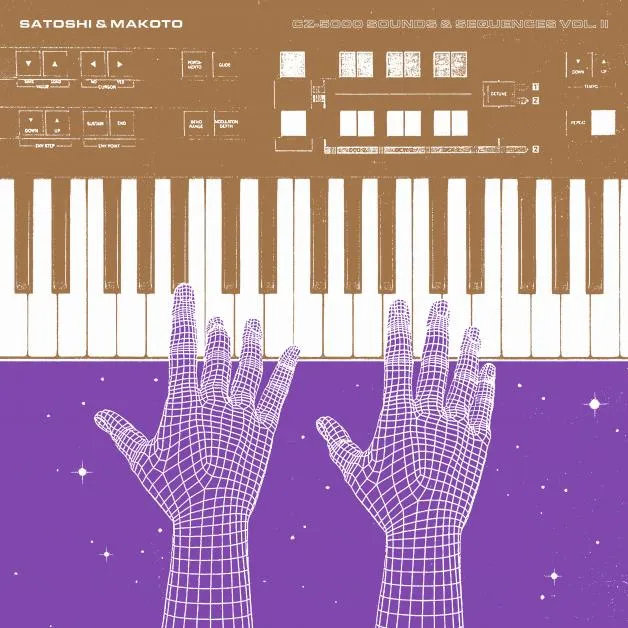- LP
- LP (used)
- Recommended
- Back In
Satoshi & Makoto
CZ-5000 Sounds & Sequences Vol. II
Safe Trip - Cat No: ST019
- updated:2021-03-04
CHEE SHIMIZUサポートのもとYOUNG MARCO主宰のレーベル〈SAFE TRIP〉から発見され話題を読んだ、日本人の双子デュオSATOSHI & MAKOTOのさらなる音源が到着しました。
Track List
Scientific Bulletin From The Safe Trip Institute, Amsterdam.
Our latest communication to colleagues concerns an audio artefact – library reference code ST019 – provided by our esteemed Japanese brothers Satoshi and Makoto. They unearthed it from their own archive of musical experimentations and laboratory tests, which have been ongoing since the 1990s. They have shared it so that the process of peer reviewing can begin in earnest.
We have undertaken thorough testing in the Safe Trip Laboratory and offer the following observations:
Colleagues in Japan provided us with sample product of the following audio artefact – file number ST015 – believing that it may be relevant to the Safe Trip Institute’s ongoing research in this area of study. After rigorous testing and analysis, we would like to offer the following observations:
• By running each of the 10 pieces of music that make up the artefact through the Past Fire Particle Analyzer, we have ascertained that every single note, chord and aural element was created using the CZ-5000, an electronic instriment built by Japan’s Casio Corporation.
• One of our researchers discovered that if you assign a Pantone colour code to each different musical note featured on the artefact, all bar 734 of the 1,867 “spot” colours are present. By gathering these together on one screen, she discovered that most of the “musical colours” employed by Satoshi & Makoto were shades of purple, orange, red, green, yellow and pink.
• In laboratory tests, listeners were instinctively drawn to the following percussion-free compositions: ‘Crawl Up (ST019-02)’, a combination of vibrant melodies and rumbling sub-bass; ‘Updraft (ST019-08)’, which one listener claimed helped him see through time; and ‘Kass (ST019-09)’, a musical voyage through neural pathways that should interest colleagues within the world of phrenology.
• Test subjects also responded positively to a number of other artefacts, with one insisting that ‘Corendor (ST019-03)’ induced intense feelings of joy thanks to its use of vibrant melodies and “shuffling beats”. We draw no conclusions from this comment but think it worthy of further discussion.
We invite colleagues the world over to analyse and test this audio further in order to increase our understanding of Mr Satoshi and Mr Makoto’s archive aural artefacts. We eagerly await your correspondence.
Our latest communication to colleagues concerns an audio artefact – library reference code ST019 – provided by our esteemed Japanese brothers Satoshi and Makoto. They unearthed it from their own archive of musical experimentations and laboratory tests, which have been ongoing since the 1990s. They have shared it so that the process of peer reviewing can begin in earnest.
We have undertaken thorough testing in the Safe Trip Laboratory and offer the following observations:
Colleagues in Japan provided us with sample product of the following audio artefact – file number ST015 – believing that it may be relevant to the Safe Trip Institute’s ongoing research in this area of study. After rigorous testing and analysis, we would like to offer the following observations:
• By running each of the 10 pieces of music that make up the artefact through the Past Fire Particle Analyzer, we have ascertained that every single note, chord and aural element was created using the CZ-5000, an electronic instriment built by Japan’s Casio Corporation.
• One of our researchers discovered that if you assign a Pantone colour code to each different musical note featured on the artefact, all bar 734 of the 1,867 “spot” colours are present. By gathering these together on one screen, she discovered that most of the “musical colours” employed by Satoshi & Makoto were shades of purple, orange, red, green, yellow and pink.
• In laboratory tests, listeners were instinctively drawn to the following percussion-free compositions: ‘Crawl Up (ST019-02)’, a combination of vibrant melodies and rumbling sub-bass; ‘Updraft (ST019-08)’, which one listener claimed helped him see through time; and ‘Kass (ST019-09)’, a musical voyage through neural pathways that should interest colleagues within the world of phrenology.
• Test subjects also responded positively to a number of other artefacts, with one insisting that ‘Corendor (ST019-03)’ induced intense feelings of joy thanks to its use of vibrant melodies and “shuffling beats”. We draw no conclusions from this comment but think it worthy of further discussion.
We invite colleagues the world over to analyse and test this audio further in order to increase our understanding of Mr Satoshi and Mr Makoto’s archive aural artefacts. We eagerly await your correspondence.




カシオCZ-5000を使い、1990年から制作を続けたきた双子のデュオSATOSHI & MAKOTOの未発表のアーカイブからセレクトされた「CZ-5000 Sounds & Sequences」第2弾! (サイトウ)